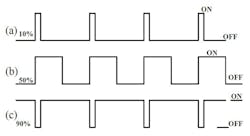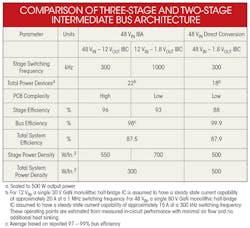The DC-DC Converter Handbook authored by David Reusch and John Glaser is intended for power-system designers who employ GaN (gallium nitride) power transistors. It supplements GaN Transistors for Efficient Power Conversion, which was published in 2012.This new book emphasizes use of enhancement mode GaN, called eGaN power transistors, for dc-dc power conversion. eGaN power transistors are normally off until turned on by a positive gate input pulse. This book does not cover depletion-mode GaN devices that are normally on.
The introductory chapter explains the performance of low-voltage power converters and why they are a promising area for reducing power consumption in data center and telecom power systems. An overview of low-power, rack-level dc-dc power-system architectures includes an analysis of key power architecture requirements, such as power density, efficiency, and cost. An analysis of various power system architectures, includes Distributed Power Architecture (DPA), Intermediate Bus Architecture (IBA), regulated and unregulated buses, isolated and non-isolated converters, and the DC Bus Architecture (DCBA).
Chapter 2 compares the electrical figure of merit (FOM) for eGaN FETs and silicon MOSFETs. Each FOM provides a simple tool for evaluating performance of the related power transistor. This chapter also introduces the thermal FOM, which is covered in more detail in Chapter 3.
By establishing performance figures of merit and using real-life data, the book concludes that GaN FETs, especially eGaN FETs, provide lower on-resistance, faster switching speeds, better thermal conductivity, smaller size, and lower cost than silicon MOSFETs. Plus, the smaller size and chip-scale approach employed by eGaN transistors results in better thermal conductivity than commercially available silicon-based component packages.
Chapter 3 discusses best design practices for use with eGaN FETs, including printed circuit board (PCB) layout and thermal management. In-circuit electrical and thermal comparisons of eGaN FETs and state-of-the-art silicon MOSFETs show that eGaN FETs exhibit higher electrical efficiency, higher thermal efficiency, and higher power density than their silicon counterparts.
This chapter also presents a thermal comparison of an eGaN monolithic half-bridge IC with discrete eGaN FETs. In addition, the book proposes a thermal figure of merit to help designers compare the thermal efficiency of different packaged devices.
Chapter 4 presents design details for an eGaN FET in an intermediate bus converter (IBC) with a nominal 48:12 input-output conversion ratio. This includes specific design examples using:
- Conventional PWM isolated converters
- Unregulated, isolated converters (hard-switched and soft-switched)
- Non-isolated converters using eGaN FETs
Conventional regulated, isolated PWM converters using eGaN power transistors exhibit a 70% increase in output power with no sacrifice in performance, when operating at twice the switching frequency of silicon power transistor converters. Extending this to unregulated converters provides at least another 33% increase in power density.
Use of eGaN FETs as non-isolated IBCs results in lower switching loss, which means high efficiencies are possible. Preliminary results suggest that efficiency can be better than the isolated design, or you can approximately double the power density. These options result in reduced cost. This means that non-isolated 48 V to 12 V converters warrant serious consideration for network and telecom power conversion applications.
Design of high-performance POL (point-of-load) converters is the subject of Chapter 5. You can improve the power density of POL converters by increasing the switching frequency to allow use of smaller-size passive components as well as higher levels of integration. Besides switching frequency, POL current handling capabilities should also increase to keep up with more demanding application requirements. This chapter points out that eGaN FETs enable higher frequencies, higher currents, and higher power density, all of which will be required for next generation POL converters.
Actual results of GaN-based converters used in a DC Bus Architecture (DCBA) are presented in Chapter 6. A comparison of estimated efficiencies and power densities for a two-stage 48 VIN-to-1.8 VOUT non-isolated IBA, and the traditional three-stage IBA approach are shown in Fig. 1(a) and 1(b), with a performance summary in Table 1. A single GaN FET can provide 1.8 VOUT when used in a power converter employing a PWM configuration. As shown in Fig. 2, the power converter’s PWM circuit must provide a very narrow pulse to produce a low voltage output. Compared to a silicon power FET, the faster switching of the GaN FET provides a “cleaner” narrow-width pulse that allows a stable 1.8VOUT.
The three-stage IBA power converters have an estimated 1.3% efficiency improvement over the direct 48 VIN to 1.8 VOUT conversion approach, however no 12 V busing losses are included. When considering the 12 V bus, whose efficiency is estimated to be 98%, the total system efficiency of the direct 48 VIN to 1.8 VOUT conversion approach is around 0.5% higher, and the estimated power density has been improved by more than 65% compared with the conventional three-stage IBA. Furthermore, when operated as a non-isolated IBC at a 300 kHz switching frequency, it will probably not require additional output capacitance for load transients. There is a clear cost and power density advantage by removing one redundant bus conversion stage, and by having a single bus converter providing 1.8 VOUT from 48 VIN. This single-step bus architecture can become a viable architecture for increasing power density in the future.
Chapter 7 summarizes the information presented in the preceding six chapters.
There is also an appendix that covers:
- GaN technology overview
- eGaN product selection table
- eGaN reliability report
- Several power conversion applications are described that are well-suited to GaN’s superior performance, including space systems and wireless power transfer
The book can be purchased from Digikey, Amazon, or here.
About the Author

Sam Davis
Sam Davis was the editor-in-chief of Power Electronics Technology magazine and website that is now part of Electronic Design. He has 18 years experience in electronic engineering design and management, six years in public relations and 25 years as a trade press editor. He holds a BSEE from Case-Western Reserve University, and did graduate work at the same school and UCLA. Sam was the editor for PCIM, the predecessor to Power Electronics Technology, from 1984 to 2004. His engineering experience includes circuit and system design for Litton Systems, Bunker-Ramo, Rocketdyne, and Clevite Corporation.. Design tasks included analog circuits, display systems, power supplies, underwater ordnance systems, and test systems. He also served as a program manager for a Litton Systems Navy program.
Sam is the author of Computer Data Displays, a book published by Prentice-Hall in the U.S. and Japan in 1969. He is also a recipient of the Jesse Neal Award for trade press editorial excellence, and has one patent for naval ship construction that simplifies electronic system integration.
You can also check out his Power Electronics blog.



